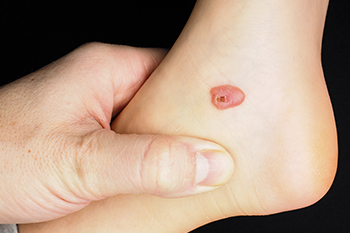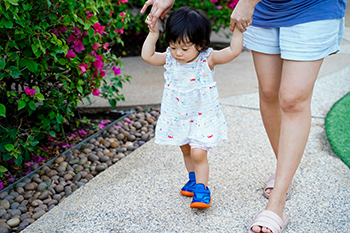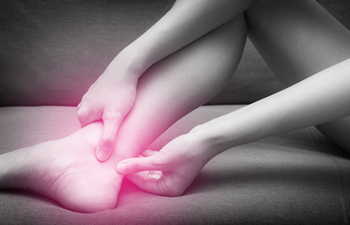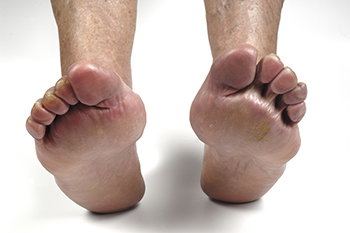Items filtered by date: February 2024
Dealing With Blood Blisters on the Feet

Blood blisters on the feet and toes can result from various factors, including sustained pressure or friction on the skin without breaking the skin’s surface. This is common in activities like running, dancing, or wearing ill-fitting shoes. Blood blisters look like friction blisters, but are filled with blood instead of clear fluid. They may appear red, purple, or black. While blood blisters may look scary, they are generally common and not usually a cause for alarm. Treatment typically involves allowing the blister to heal naturally over one to two weeks, with the formation of new skin beneath the blister. It's essential to protect the blister during this time, possibly by applying a bandage or similar protective covering. Prevention strategies to avoid developing blood blisters on the feet or toes include well-fitting footwear, protective gear during activities, and moisture-wicking socks to reduce sweat and friction. If the blood blister becomes painful or shows signs of infection, it is suggested that you make an immediate appointment with a podiatrist.
Blisters may appear as a single bubble or in a cluster. They can cause a lot of pain and may be filled with pus, blood, or watery serum. If your feet are hurting, contact one of our podiatrists of Pocono Foot & Ankle Consultants. our doctors can provide the care you need to keep you pain-free and on your feet.
Foot Blisters
Foot blisters are often the result of friction. This happens due to the constant rubbing from shoes, which can lead to pain.
What Are Foot Blisters?
A foot blister is a small fluid-filled pocket that forms on the upper-most layer of the skin. Blisters are filled with clear fluid and can lead to blood drainage or pus if the area becomes infected.
Symptoms
(Blister symptoms may vary depending on what is causing them)
- Bubble of skin filled with fluid
- Redness
- Moderate to severe pain
- Itching
Prevention & Treatment
In order to prevent blisters, you should be sure to wear comfortable shoes with socks that cushion your feet and absorb sweat. Breaking a blister open may increase your chances of developing an infection. However, if your blister breaks, you should wash the area with soap and water immediately and then apply a bandage to the affected area. If your blisters cause severe pain it is important that you call your podiatrist right away.
If you have any questions, please feel free to contact our offices located in Stroudsburg, Nazareth, and Easton, PA . We offer the newest diagnostic and treatment technologies for all your foot care needs.
Measuring Baby Shoe Sizes

Measuring your baby's feet for the right shoe size is essential for their comfort and healthy foot development. Begin by grabbing a piece of paper and a pencil to trace your baby's foot. Place the paper on a flat surface and gently press your baby's foot onto it, ensuring it lies flat without curling toes. Carefully trace the outline of their foot with the pencil. Once the outline is complete, use a ruler to measure the length from the heel to the longest toe. Repeat the process for both feet, as slight differences in size are common. With the measurements in hand, refer to the sizing chart provided by the shoe manufacturer or retailer to determine the appropriate shoe size for your baby. Remember that baby shoe sizes can vary between brands, so it is a good idea to consult the specific sizing guidelines for accurate fitting. By following these simple steps, you can ensure that your baby's feet are comfortably supported as they explore the world around them. If you are seeking more detailed guidelines about how to measure your baby’s feet or if their shoes are causing them problems, it is suggested that you confer with a podiatrist.
The health of a child’s feet is vital to their overall well-being. If you have any questions regarding foot health, contact one of our podiatrists of Pocono Foot & Ankle Consultants. our doctors can provide the care you need to keep you pain-free and on your feet.
Tips for Keeping Children's Feet Healthy
- Make sure their shoes fit properly
- Look for any signs of in-toeing or out-toeing
- Check to see if they have Clubfoot (condition that affects your child’s foot and ankle, twisting the heel and toes inward) which is one of the most common nonmajor birth defects.
- Lightly cover your baby’s feet (Tight covers may keep your baby from moving their feet freely, and could prevent normal development)
- Allow your toddler to go shoeless (Shoes can be restricting for a young child’s foot)
- Cut toenails straight across to avoid ingrown toenails
- Keep your child’s foot clean and dry
- Cover cuts and scrapes. Wash any scratches with soap and water and cover them with a bandage until they’ve healed.
If you have any questions, please feel free to contact our offices located in Stroudsburg, Nazareth, and Easton, PA . We offer the newest diagnostic and treatment technologies for all your foot care needs.
Tendonitis and Foot and Ankle Pain

Tendonitis of the foot and ankle can cause discomfort and pain, often due to overuse or injury. The tendons that connect muscles to bones become inflamed, leading to symptoms like swelling and aching. There are various types of tendonitis affecting different parts of the foot and ankle, including Achilles tendonitis, posterior tibial tendonitis, peroneal tendonitis, flexor tendonitis, and extensor tendonitis. Achilles tendonitis typically results from increased activity levels, new sports, or wearing ill-fitting footwear. It generally responds well to conservative treatments. Posterior tibial tendonitis is associated with flat feet and may require braces or orthotics. Peroneal tendonitis affects the outer ankle and can be linked to high-arched feet and previous ankle sprains. Flexor tendonitis is common among dancers and those who balance on their toes, while extensor tendonitis is often caused by friction with tight shoes or certain medical conditions. Common causes include overuse, abnormal foot structure, trauma, or underlying medical conditions such as arthritis. Diagnosis involves medical history, X-rays, or MRI scans to determine the extent of the injury. If you have tendon pain in the foot or ankle, it is suggested that you schedule an appointment with a podiatrist for a proper diagnosis and treatment, and to learn about prevention measures.
Ankle pain can be caused by a number of problems and may be potentially serious. If you have ankle pain, consult with one of our podiatrists from Pocono Foot & Ankle Consultants. our doctors will assess your condition and provide you with quality foot and ankle treatment.
Ankle pain is any condition that causes pain in the ankle. Due to the fact that the ankle consists of tendons, muscles, bones, and ligaments, ankle pain can come from a number of different conditions.
Causes
The most common causes of ankle pain include:
- Types of arthritis (rheumatoid, osteoarthritis, and gout)
- Ankle sprains
- Broken ankles
- Achilles tendonitis
- Achilles tendon rupture
- Stress fractures
- Bursitis
- Tarsal tunnel syndrome
- Plantar fasciitis
Symptoms
Symptoms of ankle injury vary based upon the condition. Pain may include general pain and discomfort, swelling, aching, redness, bruising, burning or stabbing sensations, and/or loss of sensation.
Diagnosis
Due to the wide variety of potential causes of ankle pain, podiatrists will utilize a number of different methods to properly diagnose ankle pain. This can include asking for personal and family medical histories and of any recent injuries. Further diagnosis may include sensation tests, a physical examination, and potentially x-rays or other imaging tests.
Treatment
Just as the range of causes varies widely, so do treatments. Some more common treatments are rest, ice packs, keeping pressure off the foot, orthotics and braces, medication for inflammation and pain, and surgery.
If you have any questions, please feel free to contact our offices located in Stroudsburg, Nazareth, and Easton, PA . We offer the newest diagnostic and treatment technologies for all your foot care needs.
How Rheumatoid Arthritis Affects the Feet

Rheumatoid arthritis, or RA, is an autoimmune disorder that has a profound effect on various joints, and the feet are not exempt from its reach. The chronic inflammation triggered by RA can lead to debilitating consequences for the feet, impacting their structure and function. The joints in the feet can become swollen, tender, and painful, making even simple movements a challenge. Over time, RA may cause deformities, such as bunions and hammertoes, altering the alignment of the feet. The condition also targets the synovium, a membrane surrounding joints, leading to the development of nodules. These nodules can form in the feet, further complicating already compromised mobility. Individuals grappling with RA often find themselves contending with stiffness and reduced range of motion in their feet, significantly affecting their quality of life. If you have foot pain that may be linked to RA, it is strongly suggested that you be under the care of a podiatrist who can determine what the best relief and management options are for you.
Because RA affects more than just your joints, including the joints in your feet and ankles, it is important to seek early diagnosis from your podiatrist if you feel like the pain in your feet might be caused by RA. For more information, contact one of our podiatrists of Pocono Foot & Ankle Consultants. our doctors will assist you with all of your podiatric concerns.
What Is Rheumatoid Arthritis?
Rheumatoid Arthritis (RA) is an autoimmune disorder in which the body’s own immune system attacks the membranes surrounding the joints. Inflammation of the lining and eventually the destruction of the joint’s cartilage and bone occur, causing severe pain and immobility.
Rheumatoid Arthritis of the Feet
Although RA usually attacks multiple bones and joints throughout the entire body, almost 90 percent of cases result in pain in the foot or ankle area.
Symptoms
- Swelling and pain in the feet
- Stiffness in the feet
- Pain on the ball or sole of feet
- Joint shift and deformation
Diagnosis
Quick diagnosis of RA in the feet is important so that the podiatrist can treat the area effectively. Your doctor will ask you about your medical history, occupation, and lifestyle to determine the origin of the condition. Rheumatoid Factor tests help to determine if someone is affected by the disease.
If you have any questions please feel free to contact our offices located in Stroudsburg, Nazareth, and Easton, PA . We offer the newest diagnostic and treatment technologies for all your foot and ankle needs.




